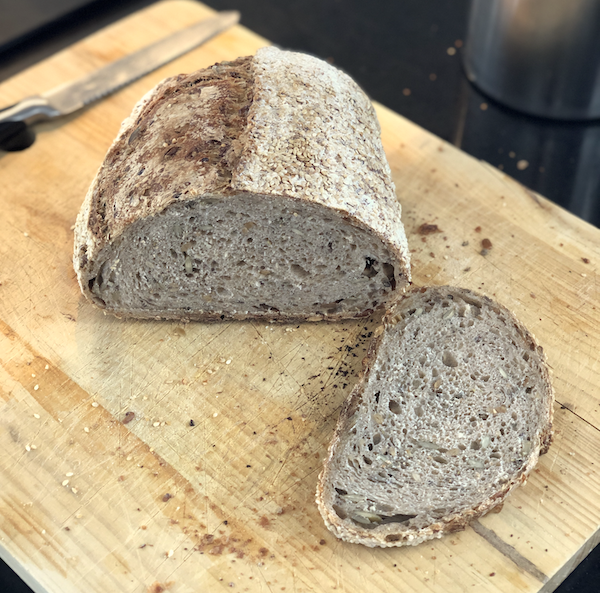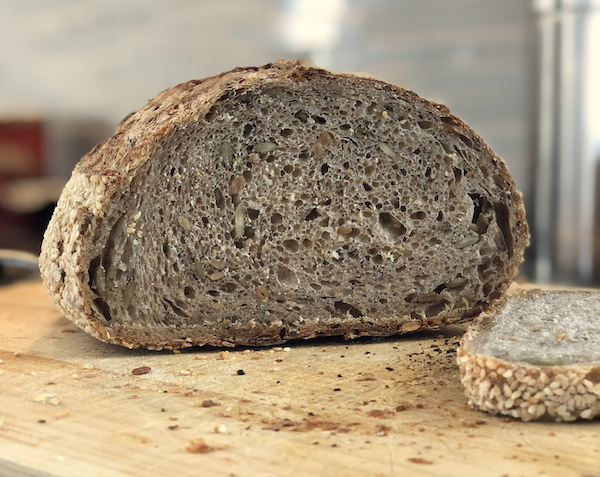Hello all you fine bakers! I experienced unfamiliar behaviour from my starter last week and I thought I'd pick your brains if I could.
When I started my sourdough journey, I basically made the same loaf approximately 12 times before I finally got it right. (Tartine basic country loaf). I've made it 3-4 times in a row now and it always comes out great, great crumb, great rise, great oven spring.
I thought I would try making something different. I saw this video for a seed loaf that caught my eye. It is quite similar to my previous loaf, but includes more whole wheat flour and 5 different seeds which are folded in during bulk.
The video in question recommended doing at 1:2:2 starter feeding for ~125g total the night before, and to do a refresher of 1:1:1 on bake day to build up to 200g, two hours before mixing in the starter. I did this, and was happy to see that my starter had no trouble peaking to over double size in around two hours with the 1:1:1 feeding.
After fully mixing the starter into the autolyse, I added the 2% salt I let it rest for ~30 minutes, then did a stretch and fold. At this point, hydration seemed too high, almost soupy. I added some flour until it came together, maybe 150g. (I don't like doing this.) This is when I pinched off a portion to use in an aliquot jar. The aliquot did not increase in size AT ALL until 8 hours later when it suddenly shot up to 50% growth. Room temperature was around 22°C during all of this. This long lag phase threw me off, I could not sufficiently judge the dough's progress in the bowl. It didn't smell yeasty, it didn't look very puffy, etc. So fearing that I was heading into over-fermentation territory, I shaped the dough and put it in the fridge right away.
The bread came out pretty good, but I noticed that the crumb was very tight with very small pockets. It got decent oven spring but was very dense.
I'm trying to figure out a few things. Why did a starter that was seemingly quite healthy and rapid, take so long to bulk ferment this loaf? What could have caused that long lag phase? Does anyone have any thoughts?
Thanks for your time.


Hi Mark! Since I make a seeded loaf nearly every week, I thought I would jump in.
I think the fact that you introduced a few new variables into your normal routine will explain the differences in what you were expecting. Specifically, most additions (like seeds) and an increase in whole wheat, as well as increasing the formula by an additional 150 g of flour can slow the 'normal' activity of your dough. That being said, I think you made a lovely, toothsome loaf...the kind I like to have for toast in the morning.
I typically make a seeded loaf with a maximum of about 20% whole wheat in order to maintain the crumb and texture that we like here. Since I do a quick soak of the seeds with warm water, the ambient heat from the seeds seems to help with fermentation. I've done two methods of incorporation in the past, as a direct mix starting with the second S&F and with a lamination method--the lamination method seems to help keep the crumb a little lighter, at least for me. I also note that the dough kind of lags for a bit because of the inclusions and then can get quite busy, so I have to keep a close eye on things. During the winter, I will set the oven on low for a bit, turn it off, crack the door if it feels too warm, then use this as my 'proofing/ferment cabinet' to help speed things along. However, I have to be VERY careful when doing this as I've come pretty close to and/or been bummed out by crossing that line of over fermenting on more than one occasion. When the dough does get too close to being over-fermented, I will pop it in the freezer for 15 minutes before the overnight retard in the fridge. This seems to halt fermentation pretty quickly. Eight hours of bulk ferment for me would definitely be over-proofed though, but in a colder environment/cool room temp might not.
I have found the aliquot jar method to be a little less reliable when making my seeded loaf. I think the larger mass of seeds and dough varies quite a bit from the small piece in the jar--I prefer to go by look and feel during coil folds towards the end of bulk and just use the aliquot jar (if I use it) as a guideline.
So, depending on the percent of whole wheat in your formula, type of whole wheat used, how many seeds, if they were soaked in warm water or not, ambient room temp, adding 'new' flour later, etc...all of this will play into an extended bulk and less airy crumb. I don't think it is a reflection of your starter, which sounded like it was happy and healthy, but more a reflection on the new recipe with different variables. Following your past method of re-making the same loaf multiple times will definitely get you to your sweet spot as far as personal preferences. Hope you will keep us posted, and happy baking!
Interesting observations. I didn't realize that whole wheat had that much of an effect, and especially didn't think the seeds would affect things. I do however pay attention to room temperature and will use a different "strike" temperature (brewing term) for the water, to try and aim for a dough temp.
But really my surprise came from the fact that the bulk behaved so much differently than the other loaf I regularly make, considering that most other variables are kept the same.
Thanks for your reply!
Mark, first off your loaf looks as good as the loaf baked in that video you linked to. I assume you followed the recipe shared for your loaf. Given the composition of the dough with a significant amount of whole wheat and a TON of seeds, I wouldn’t expect a more open crumb than that. Those seeds are heavy and it is hard to achieve anything more open with that much extra weight to raise.
In terms of your question and the lag time, I wonder if your seeds slowed things down when they were added? Were the seeds kind of cool by any chance? Your room temperature was coolish so 8 hour bulk doesn’t seem that far off to me. The extra weight of the seeds may have contributed to the apparent slow rise of the aliquot jar with the extra weight making it harder to rise. On 2 or 3 occasions I have found the aliquot jar to misrepresent the true rise in the main dough. I suspected in those times that the levain wasn’t adequately incorporated into the dough and the aliquot jar dough didn’t have as much levain in it as the rest of the dough. I cannot prove that, but that was what I assumed. When I use an aliquot jar now I make sure that the dough is really really well mixed prior to removing the aliquot of dough and also that the jar itself is in direct contact with the dough during bulk fermentation to try to ensure that the temperature of the aliquot dough is the same as the main dough. So every time the dough comes out of the proofing box so does the aliquot jar and each time it returns to the box, the aliquot jar is touching the main dough as well.
Not sure this helps.
Oh for clarity, it can be helpful to use levain vs starter to differentiate the starter which we perpetuate and use a portion of to build a levain that goes into our dough to make the bread.
Benny
Hi Benito, thanks for the reply. But I have to say, in my opinion the bread in the video appears to have a more open crumb, and a lighter texture, you can see it bouncing softly as he tears a slice in half. Mine was much stiffer... but then again, I did add more flour at some point.
As for your observations with the aliquot, since I have started using it, it seemed quite predictable. I am generally careful about properly mixing in my leaven. This time, I pinched off a sample of dough before adding in the seeds, so it did not contain any of that. So I'm very curious what caused the lag time. Because other than the seeds and the increased whole wheat, it's the same recipe as the other loaf I usually make. Strange indeed!
As for leaven vs starter, I guess I tend to use the terms interchangeably because I don't differentiate between the two, I have a single jar where I perpetuate a "starter" I guess, and when I will be baking I simply make it larger... so I guess when I will be baking with it, it becomes a "leaven" ... but I understand for the sake of clarity on the forum, it would be less confusing for readers if I did make this distinction. Noted. :)
Thanks again!
Just my two pennies’ worth Mark, I have also noticed that rising can be slow especially in low temperature, then suddenly rise exponentially. I use the aliquot jar too and aim for 21C for which I have to very briefly pre heat my oven and keep the dough ( and aliquot) in there. It crawls along to 30% in about 5 hours then suddenly hits 60% in the next hour. As you are also a devotee of Tom Cucuzza’s you won’t be surprised, he mentions this sudden acceleration too.
The replication of the microbes and thus gas output is exponential in nature so you’re right that is what tends to happen. Nothing for the first few hours then accelerating growth. If you were to measure pH you can see it dropping before there is any noticeable growth.
I definitely have noticed that typical activity curve, but in this case I was surprised by an extremely long lag time. And I'm still quite sure I understand why it happened. I will be making another loaf of the Basic Country loaf, and I will see what happens this time!
I'm starting to wonder if the batch size may have something to do with it. I can't see how it would, but it is the first time I make two loaves in one batch... More thermal mass perhaps?
Benny interesting point about making sure the levain is fully incorporated into the dough before breaking off the sample for the aliquot. I will make sure to remember that.